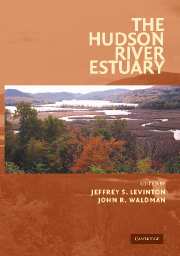Book contents
- Frontmatter
- Contents
- Preface
- List of Contributors
- The Hudson River Estuary
- 1 The Hudson River Estuary: Executive Summary
- GEOLOGICAL, PHYSICAL, AND CHEMICAL SETTING OF THE HUDSON
- PRIMARY PRODUCTION, MICROBIAL DYNAMICS, AND NUTRIENT DYNAMICS OF THE HUDSON
- HUDSON RIVER COMMUNITIES, FOOD WEBS, AND FISHERIES
- CONTAMINANTS AND MANAGEMENT ISSUES OF THE HUDSON RIVER ESTUARY
- 22 The History and Science of Managing the Hudson River
- 23 Hudson River Sewage Inputs and Impacts: Past and Present
- 24 PCBs in the Upper and Tidal Freshwater Hudson River Estuary: The Science behind the Dredging Controversy
- 25 Transport, Fate, and Bioaccumulation of PCBs in the Lower Hudson River
- 26 Contaminant Chronologies from Hudson River Sedimentary Records
- 27 Atmospheric Deposition of PCBs and PAHs to the New York/New Jersey Harbor Estuary
- 28 Toxic Substances and Their Impact on Human Health in the Hudson River Watershed
- 29 Impacts of Piers on Juvenile Fishes in the Lower Hudson River
- 30 Physiological and Genetic Aspects of Toxicity in Hudson River Species
- Index
- Plate section
- References
30 - Physiological and Genetic Aspects of Toxicity in Hudson River Species
Published online by Cambridge University Press: 06 January 2010
- Frontmatter
- Contents
- Preface
- List of Contributors
- The Hudson River Estuary
- 1 The Hudson River Estuary: Executive Summary
- GEOLOGICAL, PHYSICAL, AND CHEMICAL SETTING OF THE HUDSON
- PRIMARY PRODUCTION, MICROBIAL DYNAMICS, AND NUTRIENT DYNAMICS OF THE HUDSON
- HUDSON RIVER COMMUNITIES, FOOD WEBS, AND FISHERIES
- CONTAMINANTS AND MANAGEMENT ISSUES OF THE HUDSON RIVER ESTUARY
- 22 The History and Science of Managing the Hudson River
- 23 Hudson River Sewage Inputs and Impacts: Past and Present
- 24 PCBs in the Upper and Tidal Freshwater Hudson River Estuary: The Science behind the Dredging Controversy
- 25 Transport, Fate, and Bioaccumulation of PCBs in the Lower Hudson River
- 26 Contaminant Chronologies from Hudson River Sedimentary Records
- 27 Atmospheric Deposition of PCBs and PAHs to the New York/New Jersey Harbor Estuary
- 28 Toxic Substances and Their Impact on Human Health in the Hudson River Watershed
- 29 Impacts of Piers on Juvenile Fishes in the Lower Hudson River
- 30 Physiological and Genetic Aspects of Toxicity in Hudson River Species
- Index
- Plate section
- References
Summary
abstract The Hudson River Estuary has been polluted for many decades with organic contaminants including PCBs, dioxins/furans, PAHs, pesticides, and a variety of toxic metals, including cadmium and mercury. Most of these toxicants are poorly metabolized, highly persistent, bioaccumulative, and biomagnify in Hudson River populations, sometimes to record high levels. Many surveys have quantified tissue levels of these contaminants in resource species, but despite public concern and a need to evaluate toxicities for regulatory actions, few studies have directly addressed their biological impacts on Hudson River populations. With several notable exceptions, toxicant-induced perturbations are not frequently observed in Hudson River populations, even those for which high levels of exposure have been documented. This may have resulted from the ability of populations to acquire resistance to high levels of contaminants, either through genetic adaptations or compensatory physiological acclimation responses. While offering short-term benefits to impacted populations, resistance may be associated with evolutionary costs to populations and may compromise the viability of affected communities. Ideally, in the future, contaminant studies should focus on those species for which toxic alterations have been observed which may impact population viability, their levels of contamination should be quantified, and controlled laboratory experiments should be conducted to confirm that the contaminants of concern are able to induce these toxic manifestations in the affected taxon.
The Problem: Assessment of Toxicity of Hudson River-borne Pollutants
There is a need for government agencies to evaluate the toxic impacts of contaminants on the Hudson River (HR) biota to determine if damage to its populations has occurred and to guide remediation efforts.
- Type
- Chapter
- Information
- The Hudson River Estuary , pp. 441 - 464Publisher: Cambridge University PressPrint publication year: 2006
References
- 6
- Cited by



